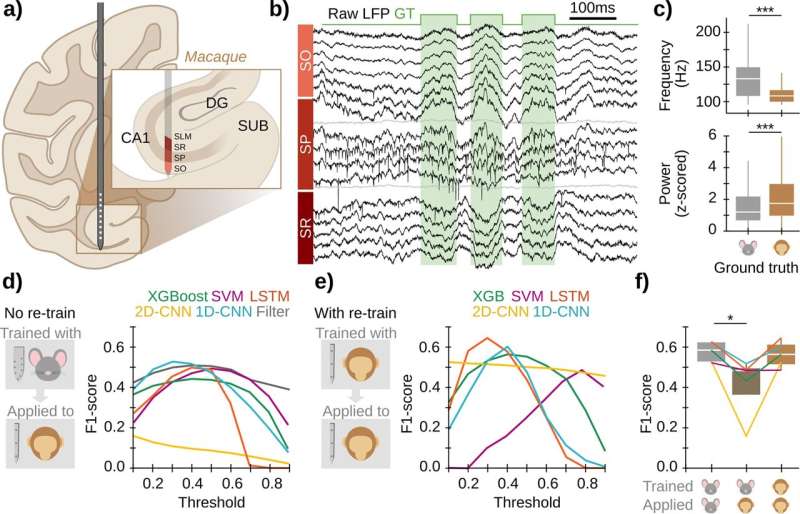This article has been reviewed according to Science X's editorial process and policies. Editors have highlighted the following attributes while ensuring the content's credibility:
fact-checked
peer-reviewed publication
trusted source
proofread
Researchers train a bank of AI models to identify memory formation signals in the brain

An international research collaboration between Vanderbilt University and the Madrid-based de la Prida lab in the Cajal Institute led to the development of AI models that detect and analyze hippocampal ripples, which are considered biomarkers of memory.
The research discoveries, outlined in an article appearing in Communications Biology, could lead to new opportunities to detect seizures and neural changes in people with Alzheimer's disease and other neurological disorders.
Kari Hoffman, associate professor of psychology and biomedical engineering at Vanderbilt, and her Ph.D. student Saman Abbaspoor worked on the study with lead authors Adrian Rubio and Andrea Navas Olive from the de la Prida lab. Hoffman is also a faculty affiliate at the Vanderbilt Brain Institute and the Data Science Institute.
As the group's research outlines, the study of brain oscillations has brought new understanding of brain function. Hippocampal ripples are a type of fast oscillations that underlie the organization of memories. They are affected in such neurological disorders as epilepsy and Alzheimer's disease, so they are considered an electroencephalographic (EEG) biomarker. However, ripples exhibit various waveform features and properties that can be missed by standard spectral methods.
The researchers set out to gain a better understanding of patterns of brain activity after scientists in the neuroscience community called for the need to better automate, harmonize and improve the detection of ripples across a range of tasks and species. In the study, the authors used recordings obtained in laboratory mice to first train a toolbox of machine learning models.
They then tested the generalizability of the models using data from non-human primates that were collected at Vanderbilt by Abbaspoor and Hoffman as part of the BRAIN Initiative. The researchers found that it is possible to train AI algorithms primarily on rodent data, and still manage highly accurate detection of ripples in primates with little to no additional training, suggesting that the AI models may be successful in humans.
The model toolbox emerged as a result of a hackathon, which resulted in a short list for the best detection models. The group identified more than 100 possible models from the different architectures that are now available for application or retraining by other researchers.
"This bank of AI models will provide new applications in the field of neurotechnology and can be useful for detection and analysis of high-frequency oscillations in pathologies such as epilepsy, where they are considered clinical markers," said Liset de la Prida, research professor at Instituto Cajal, CSIC.
"There is a great interest in taking advantage of AI to enable greater precision in detection of disease states and for oscillotherapeutics," Hoffman added. "These methods offer the promise to go beyond detecting 'where' in the brain but also to detect and ultimately correct the 'when and how' of oscillopathies."
More information: Andrea Navas-Olive et al, A machine learning toolbox for the analysis of sharp-wave ripples reveals common waveform features across species, Communications Biology (2024). DOI: 10.1038/s42003-024-05871-w
Journal information: Communications Biology
Provided by Vanderbilt University




















